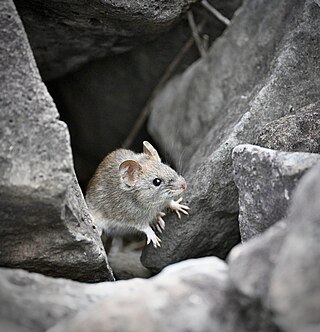
The Muroidea are a large superfamily of rodents, including mice, rats, voles, hamsters, lemmings, gerbils, and many other relatives. Although the Muroidea originated in Eurasia, they occupy a vast variety of habitats on every continent except Antarctica. Some authorities have placed all members of this group into a single family, Muridae, due to difficulties in determining how the subfamilies are related to one another. Many of the families within the Muroidea superfamily have more variations between the families than between the different clades. A possible explanation for the variations in rodents is because of the location of these rodents; these changes could have been due to radiation or the overall environment they migrated to or originated in. The following taxonomy is based on recent well-supported molecular phylogenies.

The Cricetidae are a family of rodents in the large and complex superfamily Muroidea. It includes true hamsters, voles, lemmings, muskrats, and New World rats and mice. At over 870 species, it is either the largest or second-largest family of mammals, and has members throughout the Americas, Europe and Asia.

Heteromyidae is a family of rodents consisting of kangaroo rats, kangaroo mice, pocket mice and spiny pocket mice. Most heteromyids live in complex burrows within the deserts and grasslands of western North America, though species within the genus Heteromys are also found in forests and their range extends as far south as northern South America. They feed mostly on seeds and other plant parts, which they carry in their fur-lined cheek pouches to their burrows.

The rodent subfamily Sigmodontinae includes New World rats and mice, with at least 376 species. Many authorities include the Neotominae and Tylomyinae as part of a larger definition of Sigmodontinae. When those genera are included, the species count numbers at least 508. Their distribution includes much of the New World, but the genera are predominantly South American, such as brucies. They invaded South America from Central America as part of the Great American Interchange near the end of the Miocene, about 5 million years ago. Sigmodontines proceeded to diversify explosively in the formerly isolated continent. They inhabit many of the same ecological niches that the Murinae occupy in the Old World.

The subfamily Tylomyinae consists of several species of New World rats and mice including the vesper and climbing rats. They are not as well known as their relatives in the subfamilies Sigmodontinae and Neotominae. Many authorities place all three of these subfamilies in a single subfamily, Sigmodontinae.

Sumichrast's vesper rat is a rodent of the family Cricetidae found from southern Mexico to Panama. It is named for François Sumichrast, the collector of the first specimen, and its closest relative is probably Hatt's vesper rat, a similar, but slightly smaller, species from the Yucatán Peninsula.

Oryzomys dimidiatus, also known as the Nicaraguan oryzomys, Thomas's rice rat, or the Nicaraguan rice rat, is a rodent in the family Cricetidae. It is known from only three specimens, all collected in southeastern Nicaragua since 1904. Placed in Nectomys upon its discovery, it was later classified in its own subgenus of Oryzomys and finally recognized as closely related to other species now placed in Oryzomys, including the marsh rice rat and Coues' rice rat, which occurs in the same region.

The Galápagos rice rat, also known as the Galápagos oryzomys, is a species of rodent that is endemic to the Galápagos Islands.
The gerbil leaf-eared mouse is a species of rodent in the family Cricetidae. It is found only in Peru.

The yellow-rumped leaf-eared mouse, otherwise known as the Patagonian leaf-eared mouse, is a species of rodent in the family Cricetidae and order Rodentia. It is the most widespread member of the genus.

Tylomyini is a tribe of New World rats and mice in the subfamily Tylomyinae. The rats share the characteristics of all being climbing rats.

The big-eared woodrat is a nocturnal rodent of the woodrat genus Neotoma, in the family Cricetidae. Closely related to, and formerly included in the species Neotoma fuscipes, it is endemic to western North America and occurs west and south of the Salinas Valley from the California Coast Ranges south of Monterey Bay to northern Baja California, as well as in the Sierra Nevada, extending north to the South Fork American River.

Oryzomys antillarum, also known as the Jamaican rice rat, is an extinct rodent of Jamaica. A member of the genus Oryzomys within the family Cricetidae, it is similar to O. couesi of mainland Central America, from where it may have dispersed to its island during the last glacial period. O. antillarum is common in subfossil cave faunas and is also known from three specimens collected live in the 19th century. Some historical records of Jamaican rats may pertain to it. The species probably became extinct late in the 19th century, perhaps due to the introduction of the small Indian mongoose, competition with introduced rodents such as the brown rat, and habitat destruction.

A pack rat or packrat, also called a woodrat or trade rat, are any species in the North and Central American rodent genus Neotoma. Pack rats have a rat-like appearance, with long tails, large ears, and large, black eyes. Pack rats are noticeably larger than deer mice, harvest mice, and grasshopper mice, and are usually somewhat larger than cotton rats.

Oryzomys peninsulae, also known as the Lower California rice rat, is a species of rodent from western Mexico. Restricted to the southern tip of the Baja California peninsula, it is a member of the genus Oryzomys of family Cricetidae. Only about twenty individuals, collected around 1900, are known, and subsequent destruction of its riverine habitat may have driven the species to extinction.














